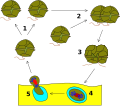Dinoflagellate
Dinoflagellates are a large group of flagellate protists. They constitute the phylum Dinoflagellata, which is classified under the supergroup Alveolata. Dinoflagellates are important components of the aquatic ecosystems and play a crucial role in the production of oxygen and the food chain.
Characteristics[edit]
Dinoflagellates are unicellular and possess two dissimilar flagella arising from the ventral cell side (the dinokont flagellation). They have a unique nuclear structure (the dinokaryon), and they exhibit diverse nutritional strategies including photosynthesis, predation, parasitism, and symbiosis.
Ecology[edit]
Dinoflagellates can be found in all aquatic environments: in freshwater, marine, and brackish habitats. They are a major component of plankton. Some species are bioluminescent and can illuminate the water at night.
Human Impact[edit]
Some dinoflagellates produce toxins that are harmful to humans and animals. These toxins can accumulate in shellfish, leading to shellfish poisoning when consumed. Dinoflagellates are also responsible for the red tide phenomenon.
Classification[edit]
Dinoflagellates are classified under the supergroup Alveolata, together with ciliates and apicomplexans. The phylum Dinoflagellata includes about 2,000 living species.
See Also[edit]
|
|
|
-
Ceratium hirundinella
-
2023 Dinoflagellate
-
Britannica Dinoflagellata 2
-
Динофитовая микроводоросль, выделенная из осадков Амурского залива в 2020 году
-
Algal bloom (akasio) by Noctiluca in Nagasaki
-
Noctiluca scintillans
-
Kayaking in the Bioluminescent Bay Vieques
-
Dinoflagellata Life Cycle
-
Oxyrrhis marina
Ad. Transform your life with W8MD's Budget GLP-1 injections from $75


W8MD offers a medical weight loss program to lose weight in Philadelphia. Our physician-supervised medical weight loss provides:
- Weight loss injections in NYC (generic and brand names):
- Zepbound / Mounjaro, Wegovy / Ozempic, Saxenda
- Most insurances accepted or discounted self-pay rates. We will obtain insurance prior authorizations if needed.
- Generic GLP1 weight loss injections from $75 for the starting dose.
- Also offer prescription weight loss medications including Phentermine, Qsymia, Diethylpropion, Contrave etc.
NYC weight loss doctor appointmentsNYC weight loss doctor appointments
Start your NYC weight loss journey today at our NYC medical weight loss and Philadelphia medical weight loss clinics.
- Call 718-946-5500 to lose weight in NYC or for medical weight loss in Philadelphia 215-676-2334.
- Tags:NYC medical weight loss, Philadelphia lose weight Zepbound NYC, Budget GLP1 weight loss injections, Wegovy Philadelphia, Wegovy NYC, Philadelphia medical weight loss, Brookly weight loss and Wegovy NYC
|
WikiMD's Wellness Encyclopedia |
| Let Food Be Thy Medicine Medicine Thy Food - Hippocrates |
Medical Disclaimer: WikiMD is not a substitute for professional medical advice. The information on WikiMD is provided as an information resource only, may be incorrect, outdated or misleading, and is not to be used or relied on for any diagnostic or treatment purposes. Please consult your health care provider before making any healthcare decisions or for guidance about a specific medical condition. WikiMD expressly disclaims responsibility, and shall have no liability, for any damages, loss, injury, or liability whatsoever suffered as a result of your reliance on the information contained in this site. By visiting this site you agree to the foregoing terms and conditions, which may from time to time be changed or supplemented by WikiMD. If you do not agree to the foregoing terms and conditions, you should not enter or use this site. See full disclaimer.
Credits:Most images are courtesy of Wikimedia commons, and templates, categories Wikipedia, licensed under CC BY SA or similar.
Translate this page: - East Asian
中文,
日本,
한국어,
South Asian
हिन्दी,
தமிழ்,
తెలుగు,
Urdu,
ಕನ್ನಡ,
Southeast Asian
Indonesian,
Vietnamese,
Thai,
မြန်မာဘာသာ,
বাংলা
European
español,
Deutsch,
français,
Greek,
português do Brasil,
polski,
română,
русский,
Nederlands,
norsk,
svenska,
suomi,
Italian
Middle Eastern & African
عربى,
Turkish,
Persian,
Hebrew,
Afrikaans,
isiZulu,
Kiswahili,
Other
Bulgarian,
Hungarian,
Czech,
Swedish,
മലയാളം,
मराठी,
ਪੰਜਾਬੀ,
ગુજરાતી,
Portuguese,
Ukrainian











